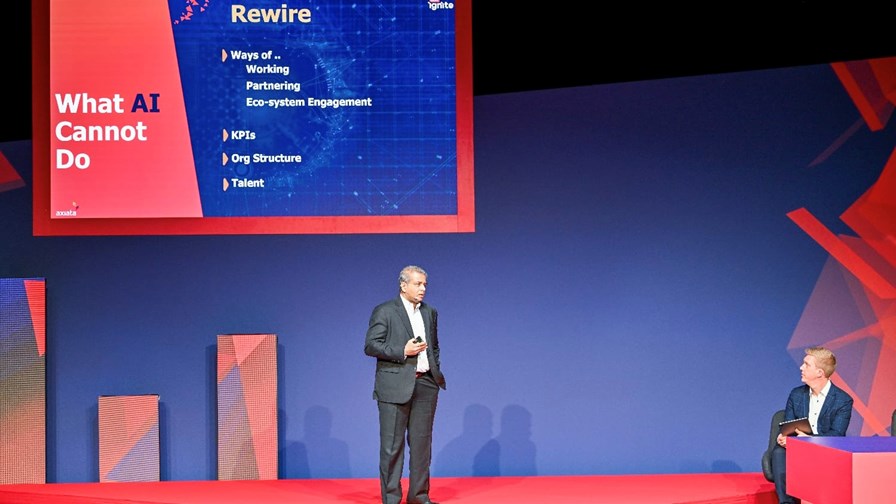
Dr Hans Wijayasuriya, CEO of the Telecommunications Business at Asian telecom and digital infrastructure giant Axiata Group, takes to the DTW24 keynote stage.
- The telco sector is still looking for a new lease of life
- Axiata’s head of telecom, Dr Hans Wijayasuriya, offered some ideas to his peers based on the Asian telco group’s recent experiences
- He told the DTW24 crowds that it’s time for telcos to unite on a global level in order to tap into an emerging services sector worth $1t
COPENHAGEN – DTW24 Ignite – Just what riches await the telco sector if it can successfully take the leap from simply offering connectivity services to developing and offering a broad range of digital applications as well? A collective pot of about $1tn per year, according to Dr Hans Wijayasuriya, CEO of the Telecommunications Business at Asian telecom and digital infrastructure giant Axiata Group.
Wijayasuriya took to the keynote stage to remind the thousands of attendees here that profitable revenues are generally hard to come by these days and that getting any return on investment is very tough. He held back from mentioning that Axiata, which has telecom operations in Malaysia, Indonesia, Bangladesh, Sri Lanka and Cambodia, as well as other digital infrastructure and services businesses, increased its full year sales last year by 9.9% to 22bn Malaysian ringgit ($4.7bn) and its EBITDA by 11.7% to 9.6bn ringgit ($2bn).
When telcos’ financial woes are mentioned, the blame is usually laid elsewhere. But Wijayasuriya posed the question, “How much of this is self-inflicted? How much is it because telcos have not addressed the fact that customers want to buy services in a different way?”
He added: “We need to move away from just providing connectivity to offering end-to-end solutions. We need to get to the promised land,” where another annual $1tn from adjacent service opportunities is up for grabs in addition to the $1tn generated annually by operators currently from connectivity services.
But to get there, telcos need to be radical and embrace a “marketplace world and future that spans the consumer internet and industrial internet,” noted the Axiata executive. “Are we ready? We’re at the point of exposing network APIs [application programmable interfaces] and we are delayering,” by decoupling certain assets from each other, and that’s a start, he noted. “But there is a huge gap between exposing APIs and capturing value” from that move, added the CEO.
“Are we going to do the tough things we need to do or lose again to disintermediation?” he asked, referring to the many lost digital services opportunities of the past few decades.
He noted that Axiata has long been engaging with the application developer community and exposing its capabilities through standardised APIs. “We work with 50,000 external developers and have thousands of internal developers too,” with more than 100 APIs exposed externally, including those exposed in league with Indonesia’s other operators, as announced in February.
But that’s not enough. “We need to partner with the hyperscalers”and offer zero-touch interactions to make things easier for everyone in the ecosystem and those involved in the end-to-end process, as well as team up and work collaboratively with other telcos.
“Peer telcos are allies in this ecosystem, not foes. If we don’t realise this, we can forget about that $1tn,” stated Wijayasuriya.
As with everything, it seems, AI has a key role to play, but the Axiata executive didn’t want to dwell on the potential of AI (much of the rest of this event seems to be about AI…) and, as he noted, “AI cannot rewire our thinking” and replace everything that is currently part of a service provider’s operations.
Instead, telcos need to capitalise on the trust and security they can offer in their pipelines and in customer engagements, and ultimately build a “solution marketplace”, expose APIs and become more open and collaborative. “But we can’t offer an everything-to-everyone marketplace… We need to be a point of value capture in the ecosystem and play to our strengths.”
And just acting locally might not be enough.
“Are marketplaces global? Yes. Are telcos global? No. We need a global network fabric, a federation of microservices that will enable telcos to address the global marketplace” and fend off another round of disintermediation, noted the Axiata executive.
Such an approach would require a major cross-sector collaboration, but industry bodies, such as the TM Forum and the GSMA, are getting better at bringing the telcos together in a unified cause. Might the TM Forum step up to the plate here? We’re waiting to hear back… But even if it could, it would still need to overcome the inertia that seems to plague many of Axiata’s peers. As one industry observer noted to me here, change is hard and not everyone’s that keen – or at least as keen as Wijayasuriya, it seems.
- Ray Le Maistre, Editorial Director, TelecomTV
Email Newsletters
Sign up to receive TelecomTV's top news and videos, plus exclusive subscriber-only content direct to your inbox.




